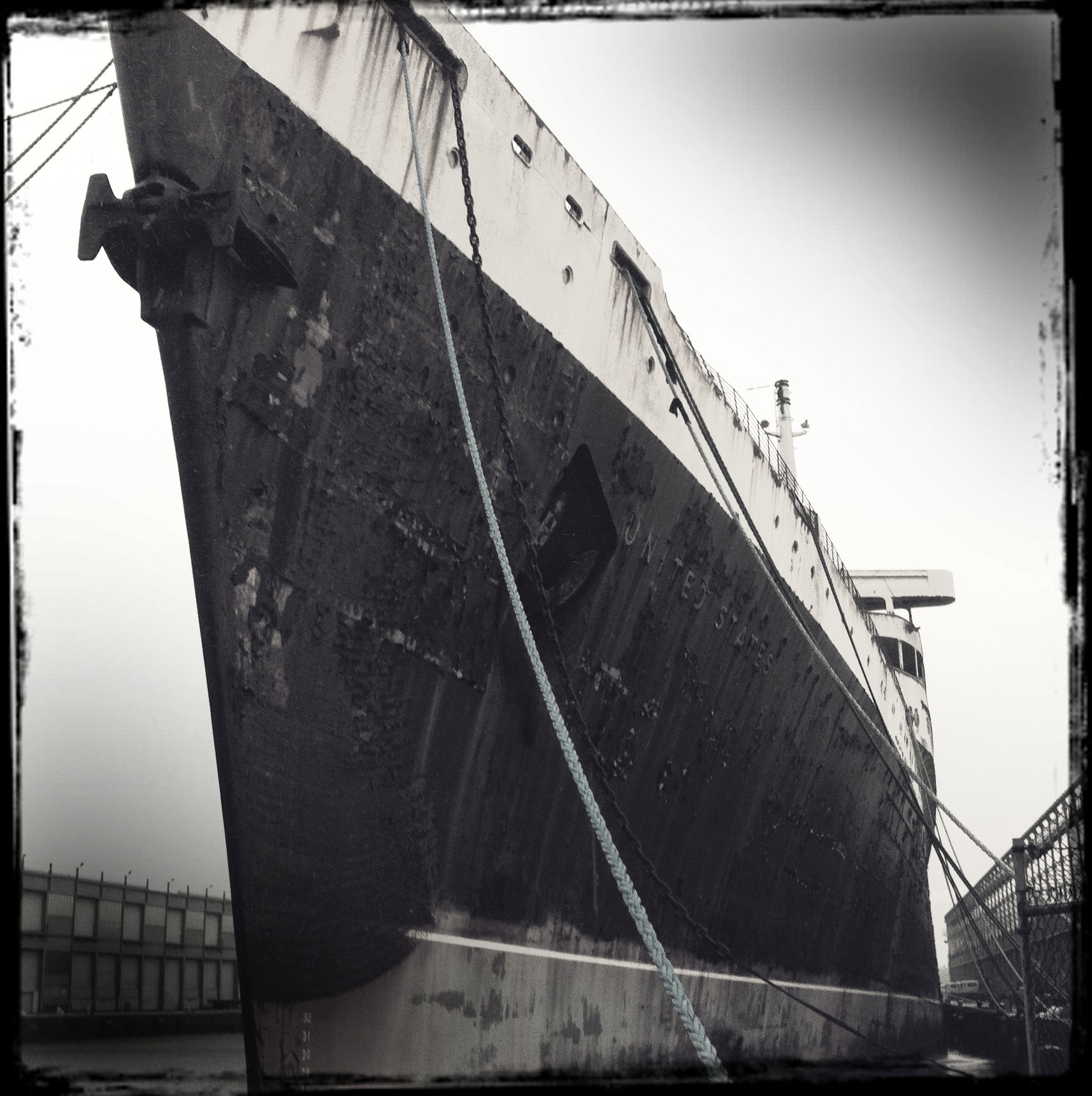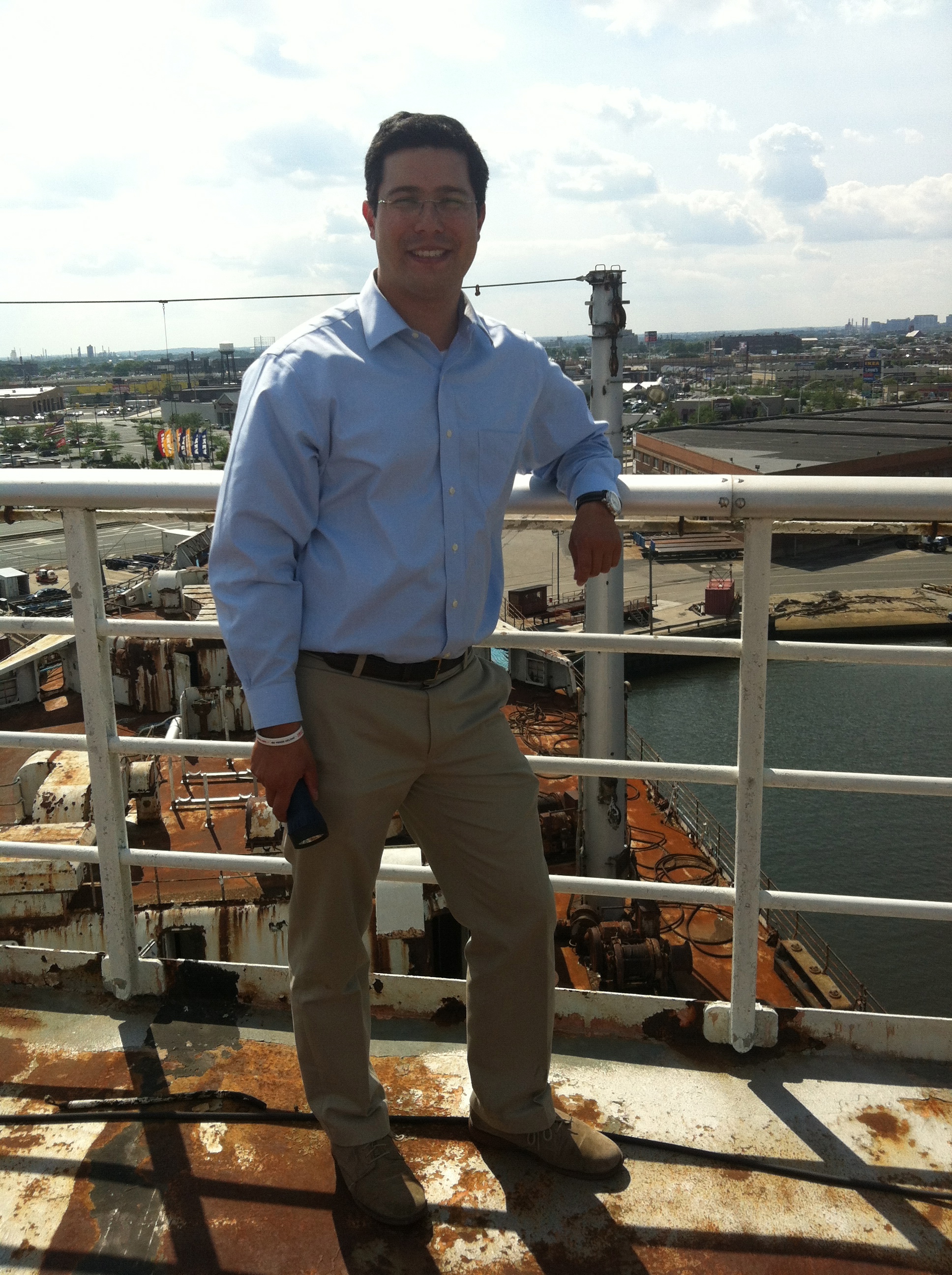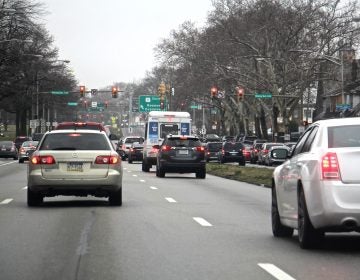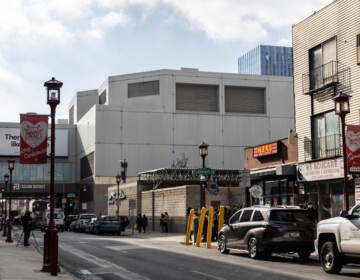Q&A: Steven Ujifusa on the SS United States

Historian Steven Ujifusa first wrote about the SS United States for PlanPhilly five years ago, and this summer we’re proud to help him celebrate the release of his book, A Man and His Ship, all about the “Big U” and its designer William Francis Gibbs.
On July 19, we are excited to join Steve in conversation about the SS United States‘ history and future at the Independence Seaport Museum for our next Behind PlanPhilly event. And on the evening of August 1, Steve will join PennPraxis’ Harris Steinberg on a Delaware River boat tour we’ve put together to bring people up close to the SS United States.
A Man and His Ship was officially released July 10, and to mark the occasion Steve was kind enough to field five questions from us about the book and the Big U. Steve is a font of knowledge about the Big U and he’s got lots of stories to share. In our exchange, Steve talks about Philly’s connection to the SS United States, how the Gibbs’ ship dusted the Queen Mary in 1952, and why the SS United States shouln’t be scrapped and turned into razor blades. Read on:

[EOTS] You started writing about the SS United States for PlanPhilly five years ago. What prompted you to take that assignment to the next level and write A Man and His Ship?
[SU] After writing about the ship itself in “Hidden Treasure on Delaware” in April 2007, I became curious about the man who designed her. He was William Francis Gibbs (1886-1967), who was an engineer with the soul of an artist. David Kuhn, a literary agent in New York, felt that the story of the naval architect and the ship he designed would make a saleable book proposal. He submitted my proposal to the Jonathan Karp, editor in chief of Simon & Schuster, who bought the book idea. I then got to work writing the book itself.
William Francis Gibbs is not an exactly household name. What should we appreciate about him as a designer?
Philadelphia-native William Francis Gibbs transformed himself from a shy and sickly introvert into a dynamic leader, capable of leading thousands to build an ocean liner. Gibbs’s lifelong dream was to build fastest, safest, most beautiful ocean liner in history. Like Frank Lloyd Wright, he was largely self-taught and a control freak — only the best materials were to be used in his ships. And like Steve Jobs, Gibbs’ real strength was not engineering, but aesthetic vision and project management. Gibbs also shared Jobs’ volcanic temper and obsession with secrecy. He personally approved every piece of furniture that came aboard the SS United States, and was paranoid about rivals stealing his ideas. No wonder he lobbied for the ship’s engines and hull design to be classified top secret by the American military.
If you could have seen her in her glory, what would you have wanted to experience about the SS United States?
I would have loved to be on the first eastbound leg of the maiden voyage, which lasted from July 3 to 8, 1952. A real highlight was when the United States passed the British liner Queen Mary on the evening of July 6. The Queen Mary, Britain’s flagship liner, had held the transatlantic speed record since 1938. A gale was brewing, the sea churning, and the wind whistling across the ship’s decks. The two speed queens, both the length of the Chrysler Building, swept by each other at a combined speed of nearly 70 miles per hour, blowing their whistles and dipping their nations’ flags in salute. To stand at the rail of the SS United States would have been an emotional moment. Early the next morning, the Queen Mary would lose the Blue Riband to the new American liner.
What part of the SS United States’ story surprised you?
I was surprised to learn that William Francis Gibbs was put before a congressional committee to face charges of war profiteering in 1944. His naval architecture firm had [become a] big business, designing nearly 70% of all American ships built during World War II, including the Liberty ship and the Normandy landing craft. In a series of high stakes hearings, Gibbs ably defended himself and walked away vindicated war hero.
I also discovered a strong Philadelphia connection: Gibbs was born here in 1886, the son of a self-made financier with business ties to the Wideners. He grew up on North Broad Street and Rittenhouse Square. At age 8, he watched the ocean liner St. Louis roar down the ways at Cramps shipyard. It was at that moment Gibbs decided to be a naval architect, despite family opposition. After his father lost his fortune, Gibbs went to New York to seek his own. Yet he always viewed himself as a Philadelphian at heart. The SS United States has come home.
What do you say to doubters of this preservation cause? Help folks understand why the SS United States should be saved, not reduced to a heap of razor blades.
David McCullough once said that great American construction projects like the Brooklyn Bridge are metaphors for “spectacular, unprecedented, often very original effort.” I feel the same way about the SS United States. Take a walk through today’s Pennsylvania Station, a nasty rabbit warren of a place. Everyone hates it. The black-and-white pictures of the original neo-classical station (demolished in the early 1960s) in the waiting room are both a reminder (and a mockery) of the grandeur that once was. The SS United States Conservancy has owned the ship since February 2011, thanks to a generous grant from H.F. “Gerry” Lenfest, and has only until November to come with a plan to redevelop the ship. Watching the SS United States getting sliced to bits on a Texas beach is not a way we should treat an irreplaceable national treasures, especially ones built to last the ages. Imagine if the Brooklyn Bridge was torn down and replaced by a “better” highway bridge.
The Conservancy is about to launch a campaign called “Paint the Big Ship” that will allow people from all walks to life to help save the SS United States. Many might say making a ship like this work in this current economical climate is impossible. Then again, plenty of people told William Francis Gibbs the same thing when he tried to follow his own dream.
Bonus Question: What is your next project?
I am working on a proposal now for another non-fiction book, most likely another American story of dreaming big and making it happen.
To learn more about the SS United States, come on out to Behind PlanPhilly on July 19th, the official launch of A Man and His Ship, and see the ship up close on a river tour on August 1. Join us.
WHYY is your source for fact-based, in-depth journalism and information. As a nonprofit organization, we rely on financial support from readers like you. Please give today.







